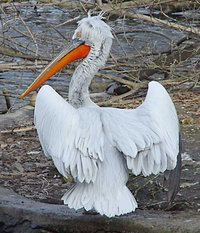Dalmatian Pelican
|
|
| Dalmatian Pelican Conservation status: Vulnerable | ||||||||||||||
|---|---|---|---|---|---|---|---|---|---|---|---|---|---|---|
 | ||||||||||||||
| Scientific classification | ||||||||||||||
| ||||||||||||||
| Binomial name | ||||||||||||||
| Pelecanus crispus Bruch, 1832 |
The Dalmatian Pelican (Pelecanus crispus) is a member of the pelican family. It breeds from southeastern Europe through Asia to China in swamps and shallow lakes. The nest is a crude heap of vegetation.
This is a large pelican, at 170 cm length and with a 3 m wingspan. It differs from the White Pelican in that it has curly nape feathers, grey legs and greyish-white (rather than pure white plumage). It has a red lower mandible in the breeding season. Immatures are grey and lack the pink facial patch of immature White Pelicans. The latter also has darker flight feathers.
This pelican migrates short distances. In flight, it is an elegant soaring bird, with the flock moving in synchrony. The neck is then held back like a heron's.
As is well known, pelicans catch fish in their huge bill pouches, most, like this species, while swimming at the surface.
Like the White Pelican, this species has declined greatly through habitat loss and persecution. As of 1994, there are around 1,000 breeding pairs in Europe, most of them in Russia, Greece, Romania and Bulgaria.
External links
- European Commission for Environment: Action plan for the Dalmatian Pelican (http://europa.eu.int/comm/environment/nature/directive/birdactionplan/pelecanuscrispus.htm)uk:Кучерявий пелікан
da:Krøltoppet pelikan fr:Pélican frisé nl:Kroeskoppelikaan pl:Pelikan kędzierzawy
